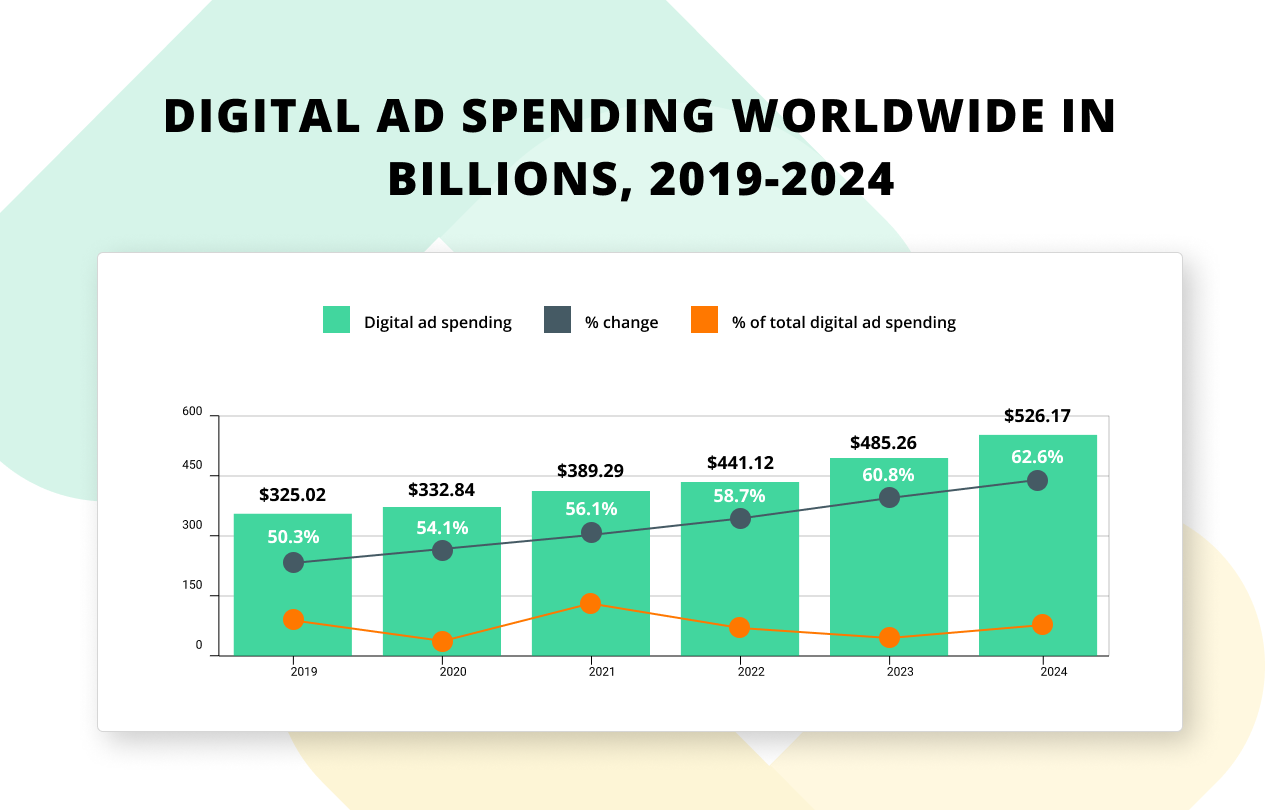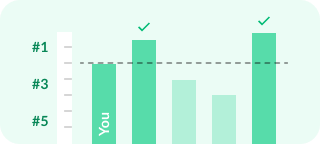
Nowadays, digital marketing is necessary. So is Keyword Gap tool.
More and more people are searching and buying products online. But customers are not buying immediately. Instead, they go on a journey — to Google around, read some articles, compare brands and see reviews before they finally make their purchase.
Digital marketing is what helps you connect with your audiences at each stage of the buyer journey. It better positions your brand to reach your target audiences and let them know why they should buy your products and how their products can fix your problems.
However, online marketing is an increasingly competitive landscape. Companies face both direct and indirect competition that are all fighting for the same attention.

According to DialogTech, the global digital advertising expenditure is currently on track to reach $389 billion in 2021 as businesses are pouring massive amounts into advertising campaigns. With many businesses competing for limited ad space, this increases the cost of acquisition – making ads more expensive than ever.
That’s why one of the best traffic generation methods remains to be SEO and content marketing. Just take a look at examples like Hubspot and Shopify that have successfully built an evergreen traffic empire using content marketing.
When it comes to finding SEO success, there is an advanced marketing skill you should better hone called keyword gap analysis.
What is Keyword Gap Analysis?

You are creating content for the internet. It goes without saying that to succeed, you need to take a minute to analyze your targeted keywords and competition.
Keyword gap research is an extension of keyword research tools and refers to the process of analyzing and comparing your keyword rankings to your competitors’ to identify keyword opportunities you may be missing.
From analyzing your competition, you can curate a list of target keywords that might be missing from your content strategy, along with insights on your competitors’ marketing strategies. This will lead you to create better content that has a higher chance of ranking.
Read up our post to learn about the difference between Keyword Gap Analysis & Content Gap Analysis.
How to Master It?

Learning keyword gap analysis can skyrocket your understanding of content marketing.
Rather than running aimlessly and creating content on every high-traffic keyword, competitive keyword analysis will allow you to learn which keywords have the best potential ROI and what you should do to win your competition.
Here, we have outlined the 3 simple steps to conduct a keyword gap analysis. So without further ado, let’s get started!
1. Use Keyword Audit to Learn About Your Competitors
When it comes to strengthening your website’s SEO, doing a periodic keyword audit is one of the most effective practices. It builds and calibrates your keyword list and helps determine which terms you should be optimizing for. Here’s how it works.
What is a Keyword Audit?
For a quick definition, a keyword audit refers to the process of analyzing and assessing your site’s existing rankings and search campaigns for insights on planning your content marketing strategy moving forward.
There are many keyword audit tools out there – both free and paid that automates that keyword auditing process. Here, we will review the steps to do a keyword audit using our own BiQ Rank Intelligence.
All you need to do is simply insert your domain URL and the tool will reveal all the keywords you are currently ranking for on Google and their breakdown.
Now, you only want a list of high potential keywords to target, so make sure you set the filter to display only keywords ranking between #1 to #20.
These are keywords you want to focus on improving to boost the ranks and get more traffic. However, most marketers just stop here.
They optimize the content and then wait to check if the ranking shows any improvement. Rinse and repeat. But this rarely shows any results as it lacks any direction for optimizing.
In any case, to truly find success in your SEO and keyword rankings, what you need to do is competitive keyword analysis.
By comparing your website’s keyword rankings with two or more competitors, you can get a much richer analysis.
That’s why put your competitors’ domain through BiQ Rank Intelligence as well, and get their list of ranking keywords and we can now start with your keyword gap analysis.
2. Use Keyword Gap Analysis for Keyword Discoveries
Basically, what you want to look for are keyword opportunities and gaps. This can be identified more easily when you categorize the ranking keywords between you and your competitors into these three fields:
- Keywords that your competitors rank, but you don’t
- Keywords you are ranking for, but your competitors don’t
- Overlapping keywords that you and your competitors are ranking for.

In addition to this labeling, it’s also important to fill in the necessary information. After all, a good keyword report should be complete with data and insights whenever we look at them.
So get a sheet ready and make sure each keyword has its corresponding data including each domain ranking position, ranking page URL, volume, CPC, competition, etc. While you are at it, classify each keyword category or niche as well.
This is important because it lets you identify unexpected keywords when you are unable to classify them, which would help you weed out keywords that are irrelevant to your business.
At the end of the day, your keyword sheet should look something like this.
Now that it is complete, you can start going through the keyword list to see if there are any repeating patterns. Like for example: is your domain mostly ranking for long-tail keywords or short-tail keywords?
Here are some questions you should be asking when going through the list:
- Are there any patterns for search terms ranking on Page 1? For example, are the keywords mostly singular or plural? Are they long-tail or short-tail keywords? and so on.
- How many keywords did your competitors include on their page? This is especially important for overlapping keywords that both you and your competitors share. You want to find out if any keywords are missing from your page and take this opportunity to optimize your content to target those terms.
- What is the type of content surrounding a high-ranking keyword? Does the SERP for the keyword have a higher preference for image or video results? Did your competitor create a video or infographic for that search term?
- What are the ranking keywords with answer box or featured snippet? Which domain is getting more featured snippet results?
- Are there any valuable keywords you missed? Like for example, keywords with high volume, related to your business or buyer keywords that are likely to convert.
- Has the search algorithm shown a ranking preference for certain topics? This will get you an idea of what each domain has built relevancy for over the web and allow you to identify their strengths and weaknesses.
Of course, there are many other questions you can be asking. But most importantly, you should find the answer to: What are the keywords you could potentially rank for, or what are the keywords you could rank for better?

Once you have your potential keywords, rank them to find out which are the ones you should prioritize. You can sort it by keyword volume to see which offers the best ROI or look at your top-ranking keywords to build on your strength.
For a broader view, you can also arrange it according to its categories to see which niche provides the most popular keyword groups.
This can also help you identify keyword topics that might have high cumulative traffic. Because sometimes dozens of smaller, niche keywords can add up to high cumulative traffic and give you a competitive edge.
Look at your data from different angles to identify potential keyword opportunities. Transform the analyzed and collected data into your weapon to outperform your competitors.
Read up the ultimate guide to Keyword Gap Analysis here!
3. Begin Drafting Your Copy
With your keyword list ready, now it’s time to start optimizing your existing content or start creating a brand new page for your keyword.
Here we suggest doing it on our BiQ Content Intelligence. It’s perfect for both optimizing existing content or creating new content.
For existing content, just paste your URL and main keyword into the tool and it will give you a quick SEO analysis based on the Word Vector module.
The tool adds another level of competitive analysis by comparing your content against the Top 10 organic ranking results in SERP and tells you how relevant your writing is and if your keyword density is up to par.
Additionally, you can also get a glance at your content readability and sentiment analysis that lets you know if your content caters to your target audience.
Meanwhile, for creating new content, you can just insert your target keyword and start writing. The block editor will provide you real-time analysis and suggestions to make sure your content is SEO-friendly.
Conclusion
Ultimately, your competition should be part of your marketing equation.
Keyword gap analysis or competitive analysis is often overlooked in digital marketing strategies, as most search marketers just stop at the keyword research phase.
Without having any knowledge of your competitors and how search engines perceive your target keywords, it will be a challenge to really succeed in the SERPs.
That’s why make sure you follow the steps in this guide to master the keyword gap analysis process to build a solid content marketing strategy that outranks your competitors.
You can try out Keyword Gap Analysis in our other tool – RankingGap.
To your success!

